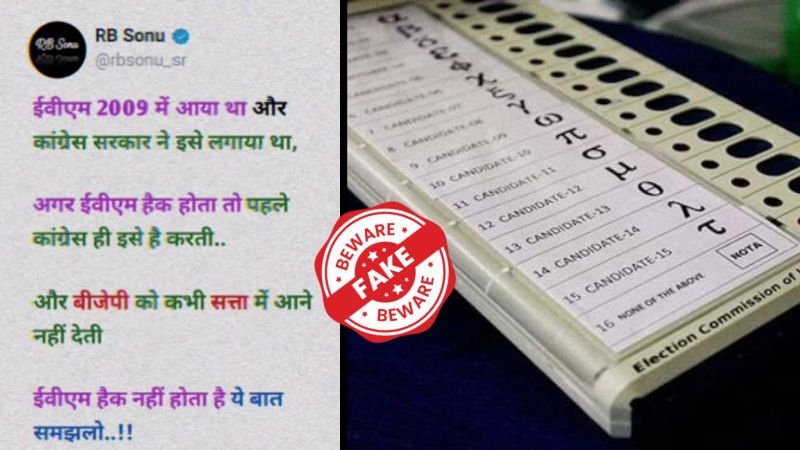- May 20, 2024
- 5 minutes read
Fact Check: Debunking the Claim of Voting Machine Introduction in India in 2009

Electronic voting machines (EVMs) were said to have been used for the first time in the country in 2009, when Congress was in charge. This report went viral on social media.
Vishvas News looked into this report and found it to be false. In 2004, they were used in all 543 Lok Sabha seats across the country. Before that, they had been used in a number of state elections. During the 2001 assembly elections in Tamil Nadu, Kerala, Puducherry, and West Bengal, EVMs were used in all places. Also, EVMs were slowly adopted during the assembly elections of different states. The first elections for 16 assembly seats in Madhya Pradesh, Rajasthan, and Delhi were held in 1998.
What Is Viral?
When ‘rbsonu_sr’ shared the popular post (old link), they said, “EVMs came in 2009 and were set up by the Congress government. If EVMs were hacked, Congress would have done it first… and BJP would have done it.” Don’t let you get power… “Know that EVMs can’t be hacked!”
Investigation:
We looked at the papers on the Election Commission’s website to see if the claim going around about the use of EVMs was true. We found a copy of the Status Paper on EVM (Edition – 3) during our research. This paper tells you how to use EVM step by step.
Based on what we know now, electronic voting machines (EVMs) were used in the elections for 16 assembly seats in Madhya Pradesh, Rajasthan, and Delhi after everyone agreed to use them in 1998.
At the end of 1999, EVMs were used in 46 seats in the house, and in the Haryana Assembly elections, they were used in 45 seats.
EVMs were used exclusively in the 2001 assembly elections in Tamil Nadu, Kerala, Puducherry, and West Bengal. They were also used in all future assembly elections.
2004 Lok Sabha elections
Every one of the 543 Lok Sabha places in the 2004 election used an EVM. This 2018 report says that “Since 2000, EVMs have been used during voting in a total of 113 state assembly elections and three general elections (2004, 2009, and 2014) in India.”
The 2019 Lok Sabha polls were also completely run by EVMs. So, the claim in the post that went popular that EVMs were first used in 2009 is not true.
It is important to note that on May 19, 1982, the ECI published rules under Article 324 of the Indian Constitution and 50 polling places in Kerala’s 70-Paravur assembly constituency used EVMs. After this, 10 by-elections in 1982 and 1983 also used EVMs. But because there wasn’t a clear law, these polls were challenged in the Supreme Court (AC Jose filed Election Petition 01 of 1982). On March 5, 1984, the Supreme Court said that EVMs can’t be used in elections without a clear law.
After that, in December 1988, the Parliament changed the law by adding Section 61A to the Representation of the People Act 1951. This let the ECI use EVMs. On March 15, 1989, this change went into force. After that, in the case of AIDMK vs. Chief Election Commissioner and others (2002 UJ (1) 387), the Supreme Court said that Section 61A was legal under the Constitution.
In the chart below, you can see more information about cases and legal interference with EVMs.
Vishvas News talked to a spokesperson for the Central Election Commission about the post that went viral. The spokesperson stated that all Lok Sabha seats used EVMs to vote in the 2004 general election, and that EVMs had also been used in previous assembly elections.
It is interesting to note that in 2018, the country’s Supreme Court turned down a plea calling for elections to be run without electronic voting machines (EVNs).
The news story in Economic Times on November 22, 2018, said, “The Supreme Court turned down the petition to use paper ballots instead of EVMs in the upcoming Lok Sabha and assembly elections.” Any method has flaws, the court said. For the NGO Nyaya Bhoomi, A Subba Rao filed this PIL with the court. He said that EVMs could be hacked and should not be used in elections because of this.
Because of what the Supreme Court said, only electronic voting machines (EVMs) were used in the 2019 general elections. Checking the truth of other online claims about EVMs can be read here.
The Instagram user who shared the post that went popular has about 5,000 followers. The Election Commission’s notification (archive link) says that voting has already taken place in four stages of the Lok Sabha elections. The fifth phase, which will include voting on 49 seats in eight states and union territories on May 20, is set to happen.
In conclusion, it is not true that EVMs have been around since 2009. All 543 Lok Sabha seats in the country used EVMs for their 2004 elections. Before that, they had been used in many state elections. In 2001, all places in the assembly elections in Tamil Nadu, Kerala, Puducherry, and West Bengal used electronic voting machines. EVMs were also slowly introduced during the assembly elections of different states. The first polls with EVMs were for 16 assembly seats in Madhya Pradesh, Rajasthan, and Delhi in 1998. EVMs were also used in the general elections of 2004, 2009, 2014, and 2019. They are also being used in the 2024 Lok Sabha polls, which are still going on.
